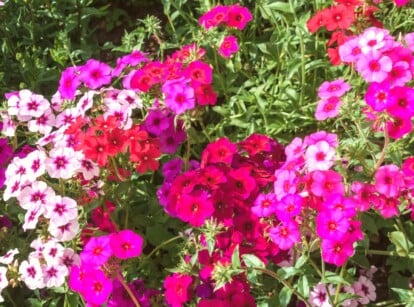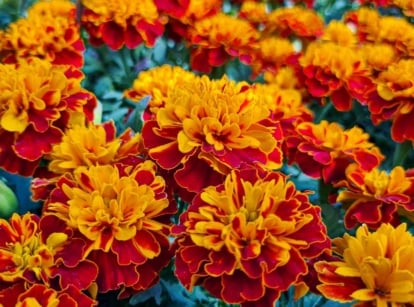13 Beginner-Friendly Hydrangea Varieties
Hydrangeas can be tricky to grow, especially for a beginner gardener. Some varieties are sensitive to poor soil drainage, incorrect soil pH, too much sun, pruning at the wrong time, over-fertilizing, and too much water. Luckily, these 13 beginner-friendly hydrangea varieties will reward you with stunning blooms and low maintenance needs. Gardening expert Kelli Klein describes each variety in detail so you can choose the right one for your garden.

Contents
Some varieties of hydrangea can be quite demanding. In particular, the popular blue varieties you might see in your mind when imagining a hydrangea. These varieties only produce blue flowers if the soil pH is at the perfect level of acidity. If the soil is neutral to basic, the flowers will turn pink.
If you don’t live in an area with naturally occurring acidic soil, it can be frustrating for a beginner gardener to attempt to get the soil pH right. However, plenty of beginner-friendly pink, white, and even green varieties can create a beautiful flowering hedge row.
Poor soil drainage and over-watering can also plague beginner gardeners attempting to grow a demanding variety of hydrangea. However, a few varieties can be drought tolerant, making forgetting to water them no big deal. Plus, these beginner-friendly hydrangeas can tolerate various sun conditions, eliminating the issues you might face with standard varieties getting too much sun. Not to mention that a few of these varieties have minimal pruning requirements if you need to prune them at all.
Oakleaf Varieties
Oakleaf hydrangeas, or Hydrangea quercifolia, are the easiest hydrangea varieties to grow. The common name refers to the large oak-shaped foliage that sets them apart from other varieties. This North American native shrub can grow four to eight feet tall and wide. These varieties can be grown in full sun to part shade in USDA growing zones 5-9. They are drought tolerant and prefer well-draining soils.
Oakleaf hydrangeas require very little in the way of pruning. These plants bloom on old wood, so you want to keep branches from the last growing season in place to get abundant blooms. You will only need to prune to remove dead or damaged branches or give this shrub an overall shape. It’s best to prune in the late summer after it has finished flowering for the season. Most varieties of oakleaf hydrangea are white, but there are some pink varieties as well.
Alice

This variety is often referred to as the most robust and trouble-free hydrangea. This deciduous shrub can grow quite large, even for a hydrangea. It can grow up to eight feet tall and wide if left unchecked with end-of-season pruning. This variety can tolerate full to partial sun conditions and produces white blooms that fade to pink.
Blooms begin to appear in June and last through the end of July. It is not picky about soil pH, and once the blooms have faded, it will showcase beautiful red-bronze foliage in the fall until the leaves drop for the winter.
Snowflake

This variety has the longest bloom time of the oakleaf hydrangeas. It will bloom from June well into late summer. Its double blooms give it a unique appearance.
‘Snowflake’ hydrangeas prefer partial shade but can adapt to full sun conditions if kept well watered. They are fast growing, with a mature size of eight feet tall and a few feet wide. The white flowers fade to pink, and as the flowers die back, the green foliage changes to a stunning maroon color in the fall.
Ruby Slippers

If you are tight on space, then this variety of compact hydrangea is for you. ‘Ruby Slippers’ grow to a mature size of four feet tall and wide. A single shrub can be tucked into even the smallest garden.
This variety can be grown in full sun to partial shade conditions. It produces white flowers that quickly transform into a deep pink rosy hue. ‘Ruby Slippers’ thrives in heat, drought, and poor soil conditions.
Tara

The Tara oakleaf variety produces tightly spaced florets of blooms, giving it a mophead appearance without the high maintenance required for most mophead varieties. This makes it excellent as a cut flower as well.
It can be planted in full sun to partial shade conditions. ‘Tara’ hydrangeas will grow to a mature six feet tall and wide. The green oak-shaped leaves will turn a beautiful red in the fall.
Gatsby Pink

As its name would suggest, this variety produces white flowers that fade to a pretty pastel pink. It can be grown in full sun to partial sun conditions. It is a medium-sized variety that can reach a height and spread of six to eight feet.
The dark green leaves will turn mahogany red in the fall. ‘Gatsby Pink’ is also salt tolerant, making it a great choice for coastal plantings. It thrives in consistently moist, well-drained soils that you would also find along the coast.
Panicle Varieties
Panicle hydrangeas, or Hydrangea paniculata, are also known by the common name PeeGee. These beginner-friendly hydrangea varieties have excellent hardiness and drought tolerance. They can survive humid summers and cold winters alike. Their oversized blooms are the low-maintenance version of the bigleaf varieties.
Panicle hydrangeas are hardy down to USDA growing zone three and tolerate a wide range of soil conditions. They can be grown in full sun to partial shade conditions, though most will bloom best in full sun.
Unlike oakleaf varieties that bloom on old wood, panicle hydrangeas bloom on new wood. Though unnecessary, this means they benefit from a heavy prune at the end of the growing season. However, a heavy prune at the end of the growing season will help maintain its overall shape and size and encourage even more new growth the following spring.
White Wedding

The White Wedding variety produces rounded clusters of pure white flowers and prefers a full sun environment to put out the most blooms. Given full sun and kept well watered, it will reward you with tons of cut flowers for your arrangements.
It can be grown in USDA zones four through nine with a mature size of three to five feet tall and wide. Pruning is not required, but deadheading spent blooms will encourage more flowers.
Moon Dance

‘Moon Dance’ produces conical clusters of white flowers. If you’re looking for a show-stopper in the garden, then look no further. ‘Moon Dance’ can grow quite large and will steal the show as a backdrop to the rest of your flower garden. It can grow to be six to eight feet tall and four to five feet wide.
Be sure to consider its full size when choosing a planting site. It can tolerate both full sun and partial sun conditions and can be grown in USDA zones four through nine.
Strawberry Shake

This variety is perfect for a large container or planter with a smaller mature size of four to five feet tall and wide. It is fast growing, so be sure to plant in a pot that is large enough for its mature size or be prepared to repot it quickly!
The flowers start white and then fade to a light pink at the end of the season. It can be grown in USDA zones four through eight in either full sun or partial shade.
Candy Apple

This variety produces faintly green flowers that fade to pure white. As temperatures begin to cool in the fall, the flowers will take on a red-rosy hue, giving them a candy apple appearance. The long-lasting blooms with sturdy stems are great for cut flower arrangements and can be used fresh or dried.
‘Candy Apple’ can be grown in USDA growing zones four through eight in both full sun and partial sun conditions. These compact plants have a mature size of four to five feet tall and wide.
Little Lime

As its name would suggest, ‘Little Lime’ produces chartreuse flowers that will fade to white and then pink as the growing season progresses. This variety is also on the smaller side, with a mature size of three to five feet tall and wide.
It can be grown in USDA growing zones 3-9. It also has sturdy stems, which make it great as a cut flower.
Smooth Hydrangeas
Smooth hydrangeas, or Hydrangea arborescens, are native to the Southern United States. They produce large rounded, flower heads. These varieties prefer partial shade conditions to produce the best blooms. They are also less drought-tolerant than other varieties and need consistent moisture.
Like the panicle varieties, smooth hydrangeas bloom on new wood. They are fast-growing and often cut down to the ground in the winter to encourage lots of new growth the following spring. This will also help to keep them at a manageable size. This beginner-friendly hydrangea group also contains dwarf varieties that are perfect for growing in pots if you don’t have an in-ground location for them.
Incrediball

This variety is a cultivar of the native ‘Annabelle’ hydrangea. It was cultivated to produce the same plant but with stronger stems to eliminate flower flopping and allow for better use as a cut flower. As a bonus, this variety also produces four times as many flowers as its native predecessor.
This is a reward for both pollinators and people alike. The white flowers form large compact balls of blooms on big beefy stems. ‘Incrediball’ can be grown in USDA zones 3-8.
Incrediball Blush

This variety has the same highlights as the original ‘Incrediball’ variety but instead produces light pink blooms. They appear as white flowers and then blush into pink as the season progresses. This beginner-friendly hydrangea variety prefers full sun to get the most flowers possible, but will also tolerate part shade.
Invincibelle Mini Mauvette

This variety is also a cultivar of the native ‘Annabelle’ to create a smaller package. ‘Mini Mauvette’ is a dwarf hydrangea with a mature size of three to four feet tall and wide. It produces abundant flower heads on a small plant that is perfect for a patio or a deck.
Rounded flower clusters of pink-mauve blooms appear throughout the summer and into the fall. It can be grown in USDA zones three through eight and prefers full sun.
Final Thoughts
Whatever your hydrangea growing goals, there is a beginner-friendly hydrangea variety for you and your garden. Whether you are looking for a compact variety for containers, want to create a stunning hedge row, or are looking for an addition to your cut flower garden. These native varieties and cultivars are well suited to most conditions in North America and will reward you with tons of blooms for minimal effort.









